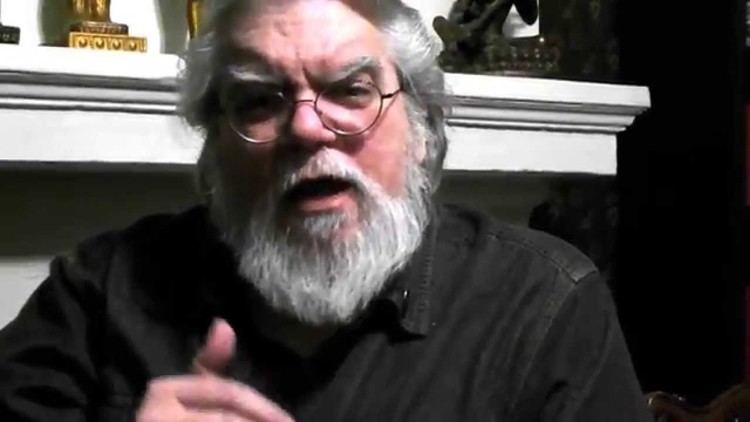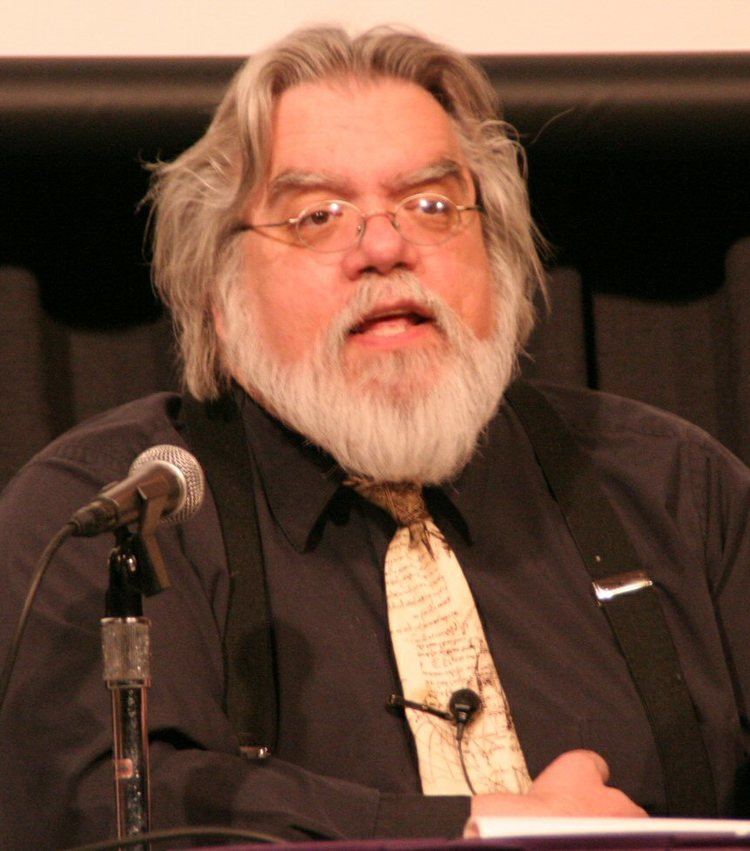Residence North Carolina Role Writer Name Robert Price | Children Victoria and Veronica Occupation Theologian Spouse Carol Selby | |
 | ||
Full Name Robert McNair Price Alma mater Montclair State UniversityGordon-Conwell Theological SeminaryDrew University Employer Professor of biblical criticism for the Council for Secular Humanism's Center for Inquiry Institute Movies Lovecraft: Fear of the Unknown Books Deconstructing Jesus, Incredible Shrinking Son of Man, The Reason Driven Life, Jesus Is Dead, The Pre‑Nicene New Test Similar People Lin Carter, Ramsey Campbell, Brian Lumley, H P Lovecraft, Thomas Ligotti | ||
Robert m price exposes william lane craig
Robert McNair Price (born July 7, 1954) is an American theologian and writer, known for arguing against the existence of a historical Jesus (the Christ myth theory). He taught philosophy and religion at the Johnnie Colemon Theological Seminary. He is a professor of biblical criticism at the Center for Inquiry Institute, and the author of a number of books on theology and the historicity of Jesus.
Contents
- Robert m price exposes william lane craig
- Atheist debates interview dr robert m price
- Background
- Religious writings
- Gospels and Acts
- Hero archetype
- Christ myth theory
- H P Lovecraft scholarship
- Other works
- Debates
- Magazines
- References

A former Baptist minister, he was the editor of the Journal of Higher Criticism from 1994 until it ceased publication in 2003. He has also written extensively about the Cthulhu Mythos, a "shared universe" created by the writer H. P. Lovecraft. He also co-wrote a book with his wife, Carol Selby Price, Mystic Rhythms: The Philosophical Vision of Rush (1999), on the rock band Rush.

Price is a fellow of the Jesus Seminar, a group of 150 writers and scholars who study the historicity of Jesus, the organizer of a Web community for those interested in the history of Christianity, and sits on the advisory board of the Secular Student Alliance. He is a religious skeptic, especially of orthodox Christian beliefs, occasionally describing himself as a Christian atheist.

Atheist debates interview dr robert m price
Background
Price was born in Jackson, Mississippi in 1954 and moved to New Jersey in 1964. He received a Master of Theological Studies in New Testament from Gordon–Conwell Theological Seminary in 1978. At Drew University he was awarded one Ph.D. in Systematic Theology in 1981 and another in New Testament in 1991. He was pastor of the First Baptist Church in Montclair, New Jersey. He has served as Professor of Religion at Mount Olive College, Professor of Theology and Scriptural Studies at Johnnie Colemon Theological Seminary and Professor of Biblical Criticism for the Center for Inquiry Institute in Amherst, New York.
Religious writings
Price believes that Christianity is a historicized synthesis of mainly Egyptian, Jewish, and Greek mythologies. Price questioned the historicity of Jesus in a series of books, including Deconstructing Jesus (2000), The Incredible Shrinking Son of Man (2003), Jesus Is Dead (2007), and The Christ-Myth Theory and Its Problems (2012), as well as in contributions to The Historical Jesus: Five Views (2009), in which he acknowledges that he stands against the majority view of scholars, but cautions against attempting to settle the issue by appeal to the majority. Price challenges biblical literalism and argues for a more sceptical and humanistic approach to Christianity.
Price argues that if critical methodology is applied with ruthless consistency, one is left in complete agnosticism regarding Jesus's historicity. Price is quoted saying, "There might have been a historical Jesus, but unless someone discovers his diary or his skeleton, we'll never know." Which is a position of agnosticism, he also similarly declared in a 1997 public debate:
If there was a historical Jesus lying back of the gospel Christ, he can never be recovered. If there ever was a historical Jesus, there isn't one any more.
Citing accounts that have Jesus being crucified under Alexander Jannaeus (83 BCE) or in his 50s by Herod Agrippa I under the rule of Claudius Caesar (41–54 CE). Price argues that these "varying dates are the residue of various attempts to anchor an originally mythic or legendary Jesus in more or less recent history."
Price does not see in the Q document a reliable source for the historical Jesus, simply because Q shows everywhere a Cynic flavor, representing a school of thought rather than necessarily the teaching of a single person. Price acknowledges that outside the New Testament there are a small number of ancient sources (Tacitus, for example) who would testify that Jesus Christ was a person who really lived. However, Price points out that, even assuming the authenticity of these references, they relate more to the claims of the Christians who lived at that time on Jesus, and do not prove that Jesus was a contemporary of the writers of antiquity.
Gospels and Acts
Price asserts that there was an almost complete fleshing out of the details of the gospels by a Midrash (haggadah) rewriting of the Septuagint, Homer, Euripides' Bacchae, and Josephus. As a fellow of the Jesus Project he also noted this in an article that he contributed, The Quest of the Mythical Jesus, writing:
I realized, after studying much previous research on the question [of Jesus], that virtually every story in the gospels and Acts can be shown to be very likely a Christian rewrite of material from the Septuagint, Homer, Euripides' Bacchae, and Josephus. ...A literary origin is always to be preferred to an historical one in such a case. And that is the choice we have to make in virtually every case of New Testament narrative. I refer the interested reader to my essay "New Testament Narrative as Old Testament Midrash," in Jacob Neusner and Alan Avery-Peck, eds., Encyclopedia of Midrash. Of course I am dependent here upon many fine works by Randel Helms, Thomas L. Brodie, John Dominic Crossan, and others. None of them went as far as I am going. It is just that as I counted up the gospel stories I felt each scholar had convincingly traced back to a previous literary prototype, it dawned on me that there was virtually nothing left. None tried to argue for the fictive character of the whole tradition, and each offered some cases I found arbitrary and implausible. Still, their work, when combined, militated toward a wholly fictive Jesus story. [...] There may once have been an historical Jesus, but for us there is one no longer. If he existed, he is forever lost behind the stained glass curtain of holy myth. At least that's the current state of the evidence as I see it.
Hero archetype
He views Jesus of Nazareth as an invented figure conforming to the Rank-Raglan mythotype. In the documentary The God Who Wasn't There, Price supports a version of the Christ myth theory, suggesting that the early Christians adopted the model for the figure of Jesus from the popular Mediterranean dying-rising saviour myths of the time, such as that of Dionysus. He argues that the comparisons were known at the time, as early church father Justin Martyr had admitted the similarities. Price suggests that Christianity simply adopted themes from the dying-rising god stories of the day and supplemented them with themes (escaping crosses, empty tombs, children being persecuted by tyrants, etc.) from the popular stories of the day in order to come up with the narratives about Christ.
[Per the Kyrios Christos Cult] The ancient Mediterranean world was hip-deep in religions centering on the death and resurrection of a savior god. [...] It is very hard not to see extensive and basic similarities between these religions and the Christian religion. But somehow Christian scholars have managed not to see it, and this, one must suspect, for dogmatic reasons. [...] But it seems to me that the definitive proof that the resurrection of the Mystery Religion saviors preceded Christianity is the fact that ancient Christian apologists did not deny it! [...] A Christ religion modeled after a Mystery cult is a Mystery cult, [and against Mack’s Christ cult] a Christ cult worthy of the name. This is what we expect Burton Mack to be talking about when he talks about Christ cults.
Price notes that historians of classical antiquity approached mythical figures such as Heracles by rejecting supernatural tales while doggedly assuming that "a genuine historical figure" could be identified at the root of the legend. He describes this general approach as Euhemerism, and argues that most historical Jesus research today is also Euhemerist. Price argues that Jesus is like other ancient mythic figures, in that no mundane, secular information seems to have survived. Accordingly, Jesus also should be regarded as a mythic figure. But, Price admits to some uncertainty in this regard. He writes at the conclusion of his 2000 book Deconstructing Jesus: "There may have been a real figure there, but there is simply no longer any way of being sure."
Christ myth theory
Price gives three key points for the traditional Christ myth theory, which originated with Bruno Bauer and the Dutch Radical School:
Price maintains that the Christ myth theory is the most likely explanation for the origin of Christianity, writing:
Let me summarize the major factors that lead me to accept the Christ Myth as the most likely hypothesis to explain the data.
e.g.H. P. Lovecraft scholarship
As editor of the journal Crypt of Cthulhu (published by Necronomicon Press) and of a series of Cthulhu Mythos anthologies, Price has been a major figure in H. P. Lovecraft scholarship and fandom for many years. In essays that introduce the anthologies and the individual stories, Price traces the origins of Lovecraft's entities, motifs, and literary style. The Cthulhu Cycle, for example, saw the origins of Cthulhu the octopoid entity in Alfred, Lord Tennyson's "The Kraken" (1830) and particular passages from Lord Dunsany, while The Dunwich Cycle points to the influence of Arthur Machen on Lovecraft's "The Dunwich Horror."
Price's religious background often informs his Mythos criticism, seeing gnostic themes in Lovecraft's fictional god Azathoth and interpreting "The Shadow Over Innsmouth" as a kind of initiation ritual.
Most of the early Cthulhu books by Chaosium were overseen by Price; his first book was The Hastur Cycle (1993), an anthology of short stories which traced the development of a single Lovecraftian element, and this was followed by Mysteries of the Worm (1993), a collection of Robert Bloch's Mythos fiction.
Other works
Price runs The Bible Geek, a broadcast show where Price answers listeners' questions. In 2010 he became one of three new hosts on Point of Inquiry (the Center for Inquiry's podcast), following the retirement of host D. J. Grothe from the show. Having appeared on the show twice before as a guest (see external links below), he hosted until 2012.
In 2005, he appeared in Brian Flemming's documentary film The God Who Wasn't There, is the subject of the documentary "The Gospel According to Price" by writer/director Joseph Nanni, and appears in the films of Jozef K. Richards in the documentary, Batman & Jesus, and comedy series, Holy Shit.
Debates
In 1999, he debated William Lane Craig, arguing against the historicity of Jesus' resurrection. In 2010, he debated James White, arguing against the reliability of the Bible. In 2016, he debated New Testament scholar Bart Ehrman on the historicity of Jesus.
Magazines
Editor of Midnight Shambler and Crypt of Cthulhu.
